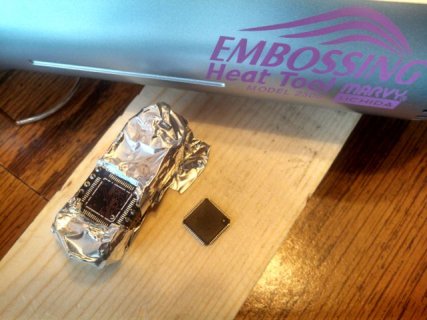keeb
Member
Ironically, while trying to find a USB cable to cut the +V wire on in order to safely power my Teensy3.1 externally, I somehow fried it. I have my usual go-to cable that I always use, but I was looking for one to slice up, so I was trying a few that I had to make sure I could program the teensy with it.
Just the facts, ma'am:
I was uploading the teensy blink example and tried one cable that didn't appear to allow me to program with it. So I tried another and was able to get the blink to work. Then I tried a third cable...nothing. After that, nothing works. It won't show up as USB device (Win7 64) no matter how I power it. I tried powering up with my known good usb cord only and also by cutting the trace and powering externally from alkalines regulated down to 5v. Never could get it to show up in windows or run the blink program that was the last successfully loaded program. The mysterious part to me is that no components or external power were connected to the teensy at the time of death, so either one of the usb cables is wired in reverse, maybe, (seems unlikely) or it was just the teensy's time to die. This was an OSHpark version that I had just started using the night before to play around with the SDfat and tinyGPS++ libraries. It was working just fine for probably 5 or 6 hours of use total up to the point it died. As far as I know I never really stressed it as far as current goes, as I never had the sd card and gps modules connected to the teensy at the same time, and it should be able to handle them both together anyways. One thing of note is that I did have the arduino ide set to overclock at 120Mhz as I had previously been trying to see if overclocking changed my SD read/write speeds at all (it doesn't). Oh yeah, the button works and I can get 3.3v regulated output when powered.
I'm not exactly concerned with how it died, although I am curious. I'm more interested in whether the Mini54 IC or the freescale IC is usually the one that fries in power related teensy deaths. I'm going to try to resurrect the teensy by attempting to replace the most likely victim first. I'm hoping it is the freescale chip, cause that mini54 is so blasted small I seriously doubt I could replace it successfully with my equipment.
As a side, it is my understanding that since the bootloader is external to the uController, I should be able to drop a fresh MK20x256vlh7 in without having to do anything to it beforehand or..umm..afterhand. Right?
Just the facts, ma'am:
I was uploading the teensy blink example and tried one cable that didn't appear to allow me to program with it. So I tried another and was able to get the blink to work. Then I tried a third cable...nothing. After that, nothing works. It won't show up as USB device (Win7 64) no matter how I power it. I tried powering up with my known good usb cord only and also by cutting the trace and powering externally from alkalines regulated down to 5v. Never could get it to show up in windows or run the blink program that was the last successfully loaded program. The mysterious part to me is that no components or external power were connected to the teensy at the time of death, so either one of the usb cables is wired in reverse, maybe, (seems unlikely) or it was just the teensy's time to die. This was an OSHpark version that I had just started using the night before to play around with the SDfat and tinyGPS++ libraries. It was working just fine for probably 5 or 6 hours of use total up to the point it died. As far as I know I never really stressed it as far as current goes, as I never had the sd card and gps modules connected to the teensy at the same time, and it should be able to handle them both together anyways. One thing of note is that I did have the arduino ide set to overclock at 120Mhz as I had previously been trying to see if overclocking changed my SD read/write speeds at all (it doesn't). Oh yeah, the button works and I can get 3.3v regulated output when powered.
I'm not exactly concerned with how it died, although I am curious. I'm more interested in whether the Mini54 IC or the freescale IC is usually the one that fries in power related teensy deaths. I'm going to try to resurrect the teensy by attempting to replace the most likely victim first. I'm hoping it is the freescale chip, cause that mini54 is so blasted small I seriously doubt I could replace it successfully with my equipment.
As a side, it is my understanding that since the bootloader is external to the uController, I should be able to drop a fresh MK20x256vlh7 in without having to do anything to it beforehand or..umm..afterhand. Right?


